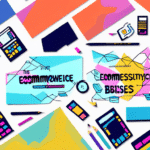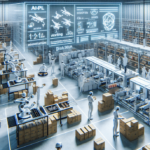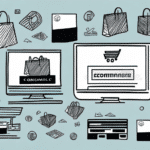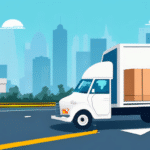Exploring the Rapid Growth of Direct-to-Consumer Fulfillment
Direct-to-consumer (D2C) fulfillment is a business model revolutionizing the delivery of goods directly to customers. This article delves into the definition, advantages, disadvantages, evolution, and comparison of D2C fulfillment with traditional fulfillment methods. We also examine the crucial role of technology, emerging trends, customer expectations, future predictions, and successful case studies from leading brands. Additionally, we'll discuss strategies for streamlining D2C fulfillment, conduct a cost analysis, assess the impact of COVID-19, and provide a comprehensive guide for international expansion and selecting the right D2C fulfillment partner.
The Definition of Direct-to-Consumer Fulfillment
D2C fulfillment is a business model where manufacturers or retailers sell goods directly to customers, eliminating intermediaries such as wholesalers, distributors, and retail stores. Products move directly from the manufacturer or warehouse to the consumer's doorstep, with the entire fulfillment process—from order processing to delivery and returns—managed by the manufacturer or retailer.
This model has surged in popularity due to the rise of e-commerce and the ease with which companies can establish online stores. By removing intermediaries, companies can often offer more competitive prices while maintaining healthy profit margins.
Moreover, D2C fulfillment allows companies to have greater control over the customer experience, from the moment an order is placed to its delivery. This control can lead to increased customer satisfaction and loyalty, as well as provide valuable data and insights into customer behavior and preferences.
The Advantages and Disadvantages of Direct-to-Consumer Fulfillment
The primary advantage of D2C fulfillment is complete control over the customer experience. Manufacturers or retailers can gather valuable customer data, enabling personalized experiences that foster brand loyalty and higher satisfaction rates. Additionally, without intermediary fees, profit margins are improved, resulting in lower costs.
However, D2C fulfillment requires significant investments in logistics and technology infrastructure. There is also a risk of overproduction if sales forecasts are inaccurate.
Another advantage is the ability to establish direct relationships with customers, facilitating immediate feedback that can be used to enhance products and services. This direct interaction helps build a stronger brand image by allowing companies to communicate their values and mission directly to consumers.
On the downside, reaching a broad audience can be challenging without the support of intermediaries like retailers or wholesalers. This limitation can constrain the potential customer base and hinder business scalability.
The Evolution of Direct-to-Consumer Fulfillment in the E-commerce Industry
The growth of e-commerce has been the primary catalyst for the evolution of D2C fulfillment. With online shopping becoming the norm, customers increasingly demand faster delivery times. According to a Shopify report, global e-commerce sales reached $5.7 trillion in 2022, underscoring the shift towards digital purchasing.
In addition to speed, D2C fulfillment offers greater control over the customer experience. By managing the entire fulfillment process internally, companies ensure that their products are packaged and shipped in a manner consistent with their brand values. This control is increasingly important as consumers become more selective about the brands they patronize.
D2C Fulfillment vs. Traditional Fulfillment: A Comprehensive Comparison
Compared to traditional fulfillment, D2C fulfillment provides enhanced control over the supply chain, inventory management, and the overall customer experience. Traditional fulfillment, however, benefits from established distribution networks, which can be advantageous for reaching customers in rural or remote areas. It is also simpler to implement, requiring fewer initial investments and leveraging well-established processes.
One significant advantage of D2C fulfillment is the ability to collect and utilize valuable customer data. This data can inform targeted marketing strategies and drive product development, allowing companies to tailor their offerings to better meet customer needs.
For more insights, refer to this Forbes article on D2C vs. traditional fulfillment.
The Role of Technology in Direct-to-Consumer Fulfillment
Technology is the backbone of successful D2C fulfillment. Advanced technologies such as artificial intelligence (AI), robotics, and the Internet of Things (IoT) are transforming the industry. These technologies optimize the supply chain, automate repetitive tasks, and enhance the customer experience.
Data analytics is one of the most significant technological benefits in D2C fulfillment. Companies can analyze customer behavior, preferences, and trends to refine product offerings and personalize marketing campaigns. Real-time inventory tracking, enabled by IoT devices, helps prevent stockouts and reduces the risk of overstocking.
According to a McKinsey report, integrating technology into the supply chain can increase efficiency by up to 20%, highlighting its critical role in maintaining competitiveness in today's fast-paced market.
Top 5 Emerging Trends in Direct-to-Consumer Fulfillment
Five emerging trends in D2C fulfillment include:
- Same-Day Delivery: As e-commerce grows, customers expect faster delivery times. Same-day delivery is becoming a competitive advantage, particularly for perishable goods like groceries and pharmaceuticals.
- Sustainable Packaging: With increasing environmental awareness, sustainable and eco-friendly packaging solutions are gaining traction.
- Social Commerce: Leveraging social media platforms for direct sales, integrating shopping experiences within social networks.
- Automation: Implementing automated systems in warehouses and fulfillment centers to enhance efficiency and reduce errors.
- Reverse Logistics: Streamlining the returns process to improve customer satisfaction and minimize costs.
For detailed information on these trends, visit ShipScience's latest blog post on emerging D2C trends.
Managing Customer Expectations with D2C Fulfillment: A Guide for Retailers
Effective management of customer expectations is crucial for a seamless D2C experience. Retailers should provide accurate delivery timelines, transparent return policies, and options such as fast delivery and order tracking.
Order Tracking and Updates: Implement automated systems to send regular updates via email or SMS about the order status, including shipping and estimated delivery times.
Transparent Communication: Clearly communicate any potential delays or issues with orders promptly. Offer solutions like discounts, refunds, or alternative delivery options to mitigate customer dissatisfaction.
According to a Bain & Company report, 80% of customers consider the ability to track their orders as a key factor in their purchasing decisions.
The Future of D2C Fulfillment: Predictions and Insights from Industry Experts
Industry experts predict continued growth in D2C fulfillment driven by the expansion of e-commerce and the demand for personalized experiences. Technological advancements in AI, IoT, and robotics are expected to further enhance D2C operations.
Last-Mile Delivery Innovations: Investments in last-mile solutions such as drones and autonomous vehicles aim to improve delivery speeds and reduce costs.
Sustainability: The emphasis on eco-friendly practices will drive innovations in sustainable packaging and carbon-neutral shipping options.
For expert insights, refer to the Forbes Technology Council's predictions on the future of D2C fulfillment.
Case Studies: Successful Implementation of D2C Fulfillment by Leading Brands
Several leading brands have successfully adopted D2C fulfillment, including:
- Nike: Nike's D2C channel increased sales and reduced shipping times by offering exclusive products online.
- Warby Parker: Their D2C model provided a cost-effective approach and enhanced customer experience through direct feedback and engagement.
- Harry's: Harry's utilized D2C fulfillment to refine product offerings and target specific customer segments effectively.
- Glossier: Glossier's approach allowed for valuable customer data collection, guiding product development based on direct feedback.
- Casper: Casper disrupted the traditional mattress industry by offering affordable prices through its D2C channel.
- Dollar Shave Club: Their innovative D2C model provided convenience and affordability, reshaping the razor market.
- Allbirds: Focusing on sustainability, Allbirds reduced its carbon footprint by shipping directly to customers.
These case studies demonstrate how D2C fulfillment can lead to significant business growth, enhanced customer satisfaction, and positive environmental impacts. For more detailed case studies, visit ShipScience's case studies page.
Streamlining D2C Fulfillment: Best Practices for Efficient Operations
Efficient operations are vital for successful D2C fulfillment. Best practices include:
- Process Automation: Utilize software solutions like warehouse management systems (WMS) and enterprise resource planning (ERP) to automate tasks such as order processing and inventory management, reducing errors and saving time.
- Real-Time Data Analytics: Implement real-time analytics to monitor supply chain performance, anticipate demand, and make informed decisions.
- Lean Inventory Management: Adopt lean inventory practices to minimize excess stock and reduce holding costs.
- Warehouse Optimization: Organize warehouse layout to maximize space utilization and streamline the picking and packing processes. Techniques like slotting optimization, cross-docking, and wave picking enhance efficiency.
Following these best practices can significantly improve operational efficiency and reduce costs. Learn more about optimizing your D2C fulfillment by visiting ShipScience's guide on streamlining D2C fulfillment.
Cost Analysis: Understanding the Economics of Direct-to-Consumer Fulfillment
Conducting a cost analysis is essential for manufacturers or retailers considering D2C fulfillment. Key factors include:
- Investment in Technology and Infrastructure: Initial costs involve setting up e-commerce platforms, warehousing, and fulfillment systems.
- Shipping and Handling Costs: Direct shipping to consumers can be more expensive per unit compared to bulk shipping to intermediaries.
- Returns Management: Handling returns directly can incur additional costs related to processing and restocking items.
However, the potential for higher profit margins and improved customer loyalty can offset these costs. A detailed cost-benefit analysis can help determine the financial viability of transitioning to a D2C model.
For a comprehensive cost analysis framework, refer to this Investopedia guide on D2C cost vs. benefit.
The Impact of COVID-19 on the Growth of D2C Fulfillment
The COVID-19 pandemic significantly accelerated the adoption of D2C fulfillment as lockdowns and health concerns drove consumers towards online shopping. According to a Statista report, D2C e-commerce sales grew by over 30% during the pandemic.
This shift is expected to remain even post-pandemic, as consumers have become accustomed to the convenience of online shopping and direct delivery models. Businesses that adapted to D2C fulfillment during the pandemic are better positioned to capitalize on the sustained increase in online consumer behavior.
Going Global with Direct-to-Consumer Fulfillment: A Guide for International Expansion
Expanding internationally with D2C fulfillment involves several critical considerations:
- Market Research: Conduct in-depth research on target markets, including consumer behavior, preferences, and purchasing power.
- Regulatory Compliance: Understand and comply with local regulations related to product standards, taxes, and import/export laws.
- Cross-Border Logistics: Partner with logistics providers experienced in international shipping to navigate customs, tariffs, and delivery challenges.
- Cultural Adaptation: Tailor marketing strategies and product offerings to align with cultural preferences and local trends.
Partnering with experienced logistics companies ensures efficient handling of international orders and helps mitigate potential challenges. For a detailed guide on international D2C expansion, visit ShipScience's international expansion guide.
Choosing the Right Partner for Your D2C Fulfillment Needs
Selecting the right partner for D2C fulfillment is crucial for operational success. Key factors to consider include:
- Location: Proximity to your customer base can reduce shipping times and costs.
- Pricing: Evaluate pricing structures to ensure they align with your budget and pricing strategy.
- Available Services: Consider the range of services offered, such as warehousing, shipping, returns handling, and technology integration.
- Customer Support: Reliable and responsive customer support is essential for addressing issues promptly.
- Alignment with Business Goals: Choose a partner whose values and capabilities align with your business objectives and growth plans.
Partnering with a reliable fulfillment provider can streamline your operations and enhance customer satisfaction. To find the best fulfillment partner, explore resources like ShipScience's checklist for selecting a fulfillment partner.
Conclusion
The rapid growth of D2C fulfillment is transforming the retail landscape, offering manufacturers and retailers the ability to control the entire supply chain, manage inventory effectively, and provide personalized customer experiences. With the right infrastructure, technology, and strategic approach, D2C fulfillment can lead to significant cost savings and higher customer satisfaction. As e-commerce continues to expand, businesses that embrace D2C fulfillment will strengthen their position as industry leaders, driving innovation and fostering deeper customer relationships.




















